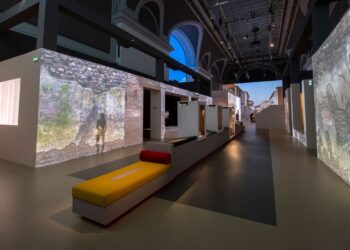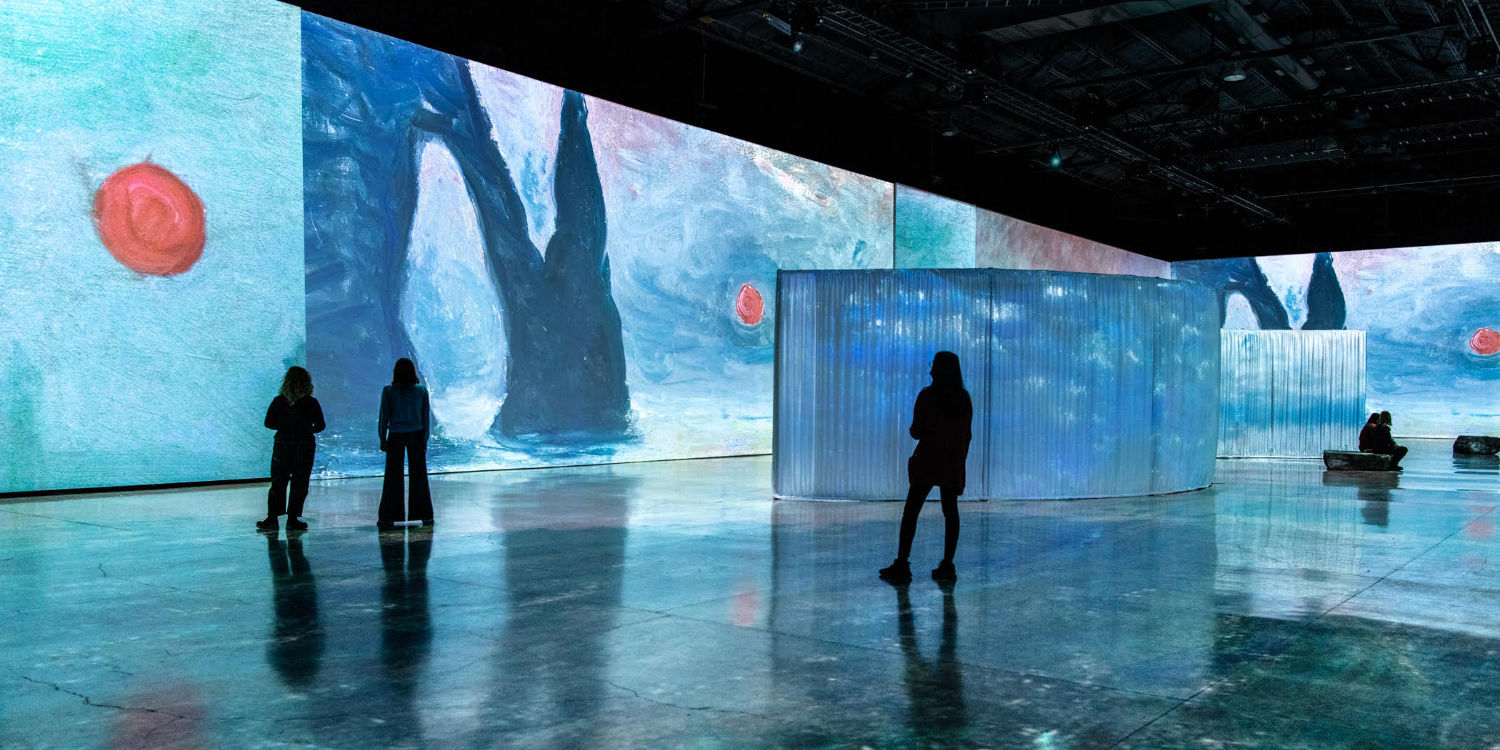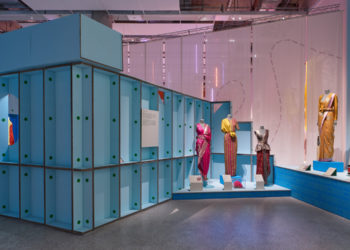The so-called ‘blockbuster exhibition’ has been a goal and reference for ‘success’ in exhibitions for quite some time. Recently, the model has been put into question in light of the Covid crisis and the rising focus on sustainability matters in cultural institutions. Is the blockbuster dead or does it still have relevance for the future of international touring? This article explores the limits of the traditional model and the possibility of defining a way in which a new blockbuster can be envisaged to support the development of sustainable models and more meaningful impacts of touring exhibitions.
Blockbuster: the catch-all word
What is a blockbuster in touring exhibitions? A widely used but infrequently defined word, blockbuster seems to primarily mean an exhibition that stands out from the crowd of more ‘ordinary’ exhibitions, as it catches the attention of the public, the media and the cultural ecosystem at large on a wider and more considerable scale, driving significantly larger audience attendance at a specific venue, including audiences who do not usually come to the venue in question. The production often has the potential to generate significant revenue, most of the time correlated with important initial investments. Its unique appeal is driven by instantly recognisable popular topics and experiences that come across as rare and exceptional “once in a lifetime opportunities”. Often defined in opposition to productions focused on home collections, community projects, or ‘niche’ topics (can the blockbuster never be correlated to such initiatives?), blockbuster productions represent a wide variety of experiences wrapped up in a single word.
But how does it work? Iconic topics, collections of masterpieces, major brands, major producer names, and productions that are heavily invested in are often considered key success factors for blockbusters. But we’ve seen shows featuring major brands and iconic objects fail, and shows with more modest names or without collections achieve great success with excellent tours. The recipe for success here remains a mystery that cannot be modelled, undoubtedly involving a certain amount of luck and good timing.
This context of transformations in the cultural world [...] has accelerated pressure on the traditional model and the urge for change.

The end of the blockbuster?
Blockbusters have been pinned down, particularly over the past couple of years, as models that should be discarded for the wasteful practices and negative impacts they involve: unsustainable carbon footprints resulting from intense travelling and heavy productions, inequalities with regard to access due to expensive ticketing and select locations, wasted resources that take funding away from community projects, among others.
Defiance towards the blockbuster is developing in a broader context where cultural institutions’ raison d’être and achievements are under scrutiny, with sustainable development and inclusivity becoming pressing issues conditioning their future, while funding continues to present considerable challenges for many organisations. A context made more complex and enriched by the diversification of stakeholders in the touring exhibitions world, notably with new entrants from a larger variety of institutions and from live entertainment and attractions organisations. This context of transformations in the cultural world, accelerated and emphasised with the multi-layered crisis triggered by the Covid pandemic, has accelerated pressure on the traditional model and the urge for change.
A new blockbuster framework
Could there be a way to reinvent the approach and purpose of the blockbuster so that some of its key fruitful elements could still be used in touring exhibitions development, whilst integrating alternative success objectives primarily based on sustainable development in the process? It seems indeed precious to still consider some blockbuster mechanisms to drive audiences back to cultural venues in the current context, with powerful and widely attractive content. How can the model of the blockbuster be reinvented for future international touring? We present here some basic avenues of reflection for the development of a new blockbuster, the sensible blockbuster.
Reframing objectives
The sensible blockbuster builds relevance by being based on a more comprehensive framework of objectives to evaluate success, which would be reassessed with each exhibition to adjust the model and progressively build a balance between demanding and sometimes contradictory objectives and aspirations. Driving high attendance and generating a balance in revenue should remain core objectives, as they reflect some relevance and contribute to economic sustainability. But the exhibition should also be aimed at attracting existing and new visitors, providing them with a worthwhile, memorable experience, whilst conveying the values and mission of the organisation, ensuring the lowest negative environmental, social and economic impact, and leaving something meaningful behind.
The exhibition is not considered an ad hoc project, but a new resource integrated in the organisation’s global exhibitions strategy, where cultural offers complement each other. Its relevance can be grounded in its ability to provide a balance in the institution’s overall content offer, bringing to light unique stories, collections and experiences that can complement and drive interest in the internal cultural offer by building connections between topics and between physical spaces, creating incentives for visitors to extend their discovery to other galleries. It can also be grounded in its ability to provide a balance in economic sustainability, generating potential extra funding which can support other exhibitions on key mission topics, local collections, community projects, and new acquisitions, while fuelling value for the local economy. The blockbuster should thus, rather than having a cuckoo effect, be conceived to generate a magnet and stimulation effect while diminishing risks with shared investments and alternative success goals for other experiences and offers at the venue and beyond.
As a touring project, it can contribute to reduced negative impacts through sharing, reuse and joint creativity, as well as with cultural diplomacy, sharing through loans as part of wider programmes of collaboration. It can also build learning opportunities, as intercultural collaborations on such major projects can foster skill development, not only in curatorial development and production, but also in the exploration of specific blockbuster marketing levers which can stimulate creativity. With its visibility, it can also be a resource for examples and best practice to inspire other productions, industries or social environments.
Smaller collections
One of the core issues primarily associated with blockbuster exhibitions is the resources involved in the presentation of large selections of original high profile collections, exceptionally gathered to provide a unique overview of a specific topic. Often coming from many lending organisations from across the globe, collections require intense international travels, with complex transport and multiple couriering and art handling, and high levels of insurance and display requirements. This is particularly true with iconic monographic exhibitions gathering large selections of masterpieces from several international locations.
It is interesting to consider here how some exhibitions manage to be associated with the blockbuster impact with few – or even without any – original collections: Pompeii Immersive attracted 200,000 visitors with only a few original objects. Immersive Van Gogh has attracted four and a half million visitors over two years with no artworks. With only one artwork, The National Gallery Masterpiece Tour manages to engage large and diverse audiences across the United Kingdom. The sensible blockbuster explores how to bring collections and stories to life differently. It reconsiders the size of collections, prioritising a treasure trove approach, with smaller selections valued by building meaning and narration around them, along with a blend of powerful marketing, storytelling and multi-layered paced experiences, integrated in smarter tours.
Smart tours
Beyond smaller collections, reconsidering the provenance of collections and experiences, curatorially prioritising, where possible, selections which can come from a limited number of lenders, ideally even just one, is also key. To minimise transport complexities and impact, the smart blockbuster can integrate reduced couriering, where couriering teams are reduced to a minimum, with remote couriering (the hosting team works with the lender team remotely), joint couriering (a lender curator manages couriering for the whole team), and local support teams (local art handlers support the installation).
Smart planning can also be considered, prioritising progressive touring, where the tour first happens in zone A, before going to zone B, and/or limited touring, where the tour is exclusively considered for a specific region, and slow touring, with longer presentations and extended hours enabling higher attendance. Paced touring should also be considered, with the shortest legs possible enabled through more dialogue and coordination between ‘neighbouring’ institutions who could host similar exhibitions.
Powerful marketing
A core blockbuster resource to consider is marketing, and the particular ability to understand and address the expectations of specific audiences, creating unique value that drives attendance and fosters engagement. The sensible blockbuster relies on a caring attention to what audiences want, to what widely resonates in terms of topics and experiences, and to popular culture and points of entry. Audience studies, exploring meaningful visitor experiences, but also host studies, assessing host experiences, can be harnessed. Traditional museum methodology can be supported here and inspired by some innovative approaches developed in live entertainment, commercial, and online content industries, where organisations such as Starvox Entertainment have designed powerful digital and on-site testing processes, making it possible to receive considerable audience feedback in a specific time window.
This consideration of audiences is complemented by a stronger attention to communicating the value of and building up the status of new exhibitions, with host audiences as well as visitor audiences. Strategies founded upon powerful branding and visual identities, with object, experience and project storytelling, and an emphasis on differentiation assets, contribute strongly to empowering projects and outweigh any potential concerns linked to collections sizes.
Sensible blockbuster marketing and productions can thus generate wider engagement and access, by building familiarity between organisations and audiences, breaking the glass doors that sometime prevent new audiences from coming in, and reinvigorating relationships with existing audiences with fresh contemporary content and a renewed offer.
Flexible multi-layered paced experiences
As epitomised by successful contemporary exhibitions, blockbusters can rely, beyond collections, on their unique ability to provide awe, learning, reflection, entertainment and wellness. The sensible blockbuster can exceed traditional classifications by bringing together a blend of contemplation, hands-on activities, interaction and contribution in the proposed experience, with high and low tech components, fast and slow paces, with wow moments, moments of reflection and light moments, as well as group and individual moments. More than quantities of objects and displays sizes, the versatility and diversity of the experience, with technology serving the narrative, learning and engagement where relevant, and its ability to enable contemporary social sharing, before, during and after the experience, can be particularly powerful.
It is significant to see how travelling exhibitions increasingly embrace a paced multi-layered approach, with exhibitions such as Wonderland by ACMI integrating the theatrical with the digital, experiences like God(s): A User Guide and the new Climate Show by Tempora incorporating live elements into the heart of the show in an innovative way, productions like Sensory Odyssey using multisensorial components, such as curated scents, projections and surround sounds, exhibitions such as the Little Curious range by Universcience blending fun and learning, and manual and digital interactives, and productions like Imagine Monet or India, Reflections of Sacred Worlds integrating slow looking and contemplation moments.
The smart blockbuster can thus seek more concentrated and diverse engagement, and sometimes consider lighter displays or smaller spaces, making sure people can spend more time in each section, with eco and inclusive scenographies designed to be usable for severable exhibitions and to integrate local displays where relevant, for longer presentations. The enabled flexibility on size might open up the possibility for more affordable productions, which could be accessible for a wider range of venues, and reach larger audiences.
A progressive and collaborative transition
A more sensible model can be envisaged to progressively discard the unsustainable practices that have given the blockbuster a bad name, whilst reinventing the assets and levers that made the approach so successful. Such a model could ensure that our industry not only responds to the global urge for sustainable development practices, but also becomes a laboratory and a source of inspiration for other industries and society at large. A progressive transition, supported by funding creativity and alternative success evaluations, will be key, so as to enable for profit as well as non-profit stakeholders to access these alternative models. Transparency, data and tools sharing can be particularly valuable when it comes to accelerating the transition, so that a sensible blockbuster can become a resource with a multi-layered positive impact potential for travelling exhibitions.












